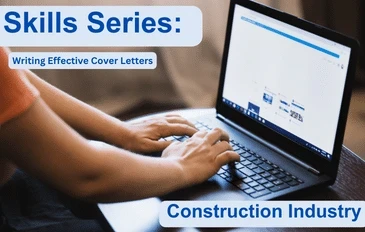Skills Series: Writing Effective Cover Letters

Skills Series: Writing Effective Cover Letters
In the construction industry, submitting a cover letter along with your resume is a common practice.
A cover letter allows you to introduce yourself to potential employers and provide additional context for your application. In this article, we’ll explore the key elements of an effective cover letter in the construction industry and provide tips for tailoring your cover letter to the job you’re applying for.
Key Elements of an Effective Cover Letter in Construction
When crafting a cover letter for the construction industry, there are several key elements that you should include to make your document stand out. These include:
- Contact Information: Your contact information should be prominently displayed at the top of your cover letter, including your full name, address, phone number, and email address.
- Salutation: Address your cover letter to the specific person who will be reviewing your application. If the job posting does not include contact information, do some research to identify the hiring manager or HR representative for the company.
- Introduction: Your introduction should briefly introduce yourself and explain why you are interested in the position.
- Skills and Experience: In the body of your cover letter, highlight your relevant skills and experience that make you a good fit for the position. Use specific examples and quantify your achievements whenever possible.
- Closing: Your closing should thank the hiring manager for considering your application and provide your contact information for follow-up.
Tips for Tailoring your Cover Letter to the Job
Tailoring your cover letter to the job you’re applying for is essential to stand out to potential employers. Here are some tips for crafting an effective cover letter that highlights your skills and experience:
- Research the company: Before crafting your cover letter, research the company to understand its mission, values, and culture. Use this information to demonstrate your knowledge of the company and explain why you are a good fit.
- Match your skills to the job: Review the job posting and identify the specific skills and qualifications the employer is looking for. Use these as a guide to highlight your relevant skills and experience.
- Use industry-specific language: Using industry-specific language and terminology can demonstrate your knowledge of the construction industry and make your cover letter stand out to potential employers.
- Customize your opening and closing: Tailor your opening and closing paragraphs to the specific company and job you’re applying for. Use this opportunity to demonstrate your knowledge of the company and express your enthusiasm for the position.
- Keep it concise: Your cover letter should be no longer than one page, so it’s essential to keep it concise and focused on the most relevant information.
Conclusion
Crafting an effective cover letter in the construction industry requires attention to detail and a focus on highlighting your skills and experience. By including key elements such as contact information, a salutation, an introduction, skills and experience, and a closing, you can create a compelling document that stands out to potential employers. By researching the company, matching your skills to the job, using industry-specific language, customizing your opening and closing, and keeping it concise, you can increase your chances of securing a job interview and landing your dream job in the construction industry.
Michael DeSafey is a leading executive recruiter for professionals in the construction, engineering, and environmental industries. He is currently the President of Webuild Staffing: www.webuildstaffing.com. To learn more about Michael, or to follow his blog, please visit www.michaeldesafey.com.
Category: Career Training, Construction, Interview And Job Search Tips, Jobs, Resume Writing
Why a Cover Letter Is Important to Land a Construction Job

Why a Cover Letter Is Important to Land a Construction Job
If you’ve entered the field of construction and engineering, the odds are in your favor. Industry careers are on the rise, as a labor shortage is driving increases in opportunities and salaries.
Don’t waste that advantage by firing off your impressive resume without an equally impressive cover letter to lead the way. A cover letter is the bridge between your resume and your dream job, guiding it safely to desk of the person with the ability to hire you. Sending a resume without one is like tossing it into the wind from the riverbank, and hoping it hits the other side instead of being swept downstream.
If you’ve entered the field of construction and engineering, the odds are in your favor. Industry careers are on the rise, as a labor shortage is driving increases in opportunities and salaries.
Don’t waste that advantage by firing off your impressive resume without an equally impressive cover letter to lead the way. A cover letter is the bridge between your resume and your dream job, guiding it safely to desk of the person with the ability to hire you. Sending a resume without one is like tossing it into the wind from the riverbank, and hoping it hits the other side instead of being swept downstream.
Construction jobs are on the rise
As stated by Ken Simonson, Chief Economist of the Associated General Contractors of America, “Contractors in most states are eager to hire. But they are unable to find qualified workers in some cases, and job openings in construction have soared as unemployment rates are at historic lows in many states.”
So it’s an ideal time to build your career in the construction field–as long as you position yourself to take advantage of the job openings out there. This means making sure you have the training you need for the job you want, and the job search materials to prove it.
Your resume should describe your qualifications and experience
The purpose of your resume is to list your work history, education, awards and achievements, in a highly readable format that uses industry keywords to demonstrate your knowledge. You should spend a significant amount of time perfecting your resume for the construction, engineering, or environmental job market.
But once you’ve created a resume that reflects your skills and how they match the type of job you want, you won’t change it often. You should keep your resume updated as your job experience and related qualifications change, but it shouldn’t change every time you apply for a position. That’s the purpose of a good cover letter.
Your cover letter highlights your personality, voice and attitude
A good cover letter should build a connection between yourself and your dream job. It should attract the attention of the hiring manager by showing you are eager and passionate about their job (not just any job) and are willing to work overtime to prove it. It gets them to actually read your resume.
A cover letter may look a little different depending on whether you are sending a “blind” letter to your dream company, responding to a specific job post, or using a third party as a networking contact. But the basics of the letter will be the same.
Do your homework
First, be sure you have a good understanding of company, its core values, and its projects. You can get this by checking out the company’s website or its printed corporate literature. Also, be sure to get a name for the hiring manager or person you want to contact. If no name is listed in the job post, use the company website to find the right contact person, or call their main number to inquire.
Doing this homework demonstrates your work ethic and attention to detail. Don’t be lazy with this, because your cover letter is your introduction, and you never get a second chance to make that first impression.
Open by naming the job you want
In your first sentence, reference the exact job post that you are responding to, or if you are sending a blind letter, name the job title you seek. You don’t need a long and rambling introduction. Your resume can explain your full experience, education and qualifications–the cover letter’s job is to get them to read it.
Use language from the job post in your letter
Read the job post thoroughly before writing your cover letter. Or if you are writing a blind inquiry, review the company info to see how they describe their employees and what they look for in new staff. Your cover letter should focus on the employer’s needs and how you meet them.
Be brief and specific. Stay focused on the company’s job requirements and how your skills and experience meet them. But go a step farther than saying it–show it by describing a project you handled, a problem you solved, or success you had that demonstrates it.
Your cover letter should focus on the company’s need and not your personal story. Include information about your hobbies or outside interests only if they relate to the job or build rapport with the hiring manager. Otherwise, keep your focus tight on what you can do for them.
Use strong action verbs
Read through your cover letter to make sure it conveys energy and action. Construction industry employers are looking to hire candidates who take initiative, solve problems, and work hard to get the job done. Your cover letter should convey that attitude.
Finish with a call to action
Don’t forget to ask for the interview! It may seem to go without saying, but employers will appreciate someone who knows what they want and isn’t afraid to ask for it. Tell them you look forward to hearing from them soon, would like to set up an interview, or will follow up in a few days to confirm they received your materials.
Don’t be pushy, but a follow-up call to verify is a good idea. Your submission could legitimately get lost in the shuffle, and that call might be the prod they need to search up your name and take a look.
Need help to build your career in construction or engineering?
WeBuild Staffing specializes in recruitment and placement of construction, engineering and environmental professionals worldwide. If you need help to craft the perfect cover letter to land your dream job, please contact www.webuildresumes.com . We’d love to help build your career.
Michael DeSafey is a leading executive recruiter for professionals in the construction, engineering and environmental industries. He is currently the President of Webuild Staffing www.webuildstaffing.com . To learn more about Michael or to follow his blog please visit www.michaeldesafey.com
